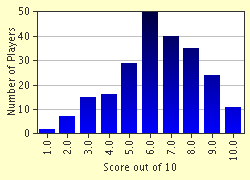Quiz Answer Key and Fun Facts
1. Which of the following is NOT an element?
2. Melodies can be conjunct or disjointed.
3. What is the name of the fastest tempo?
4. Which type of texture is being described?
A texture with a bunch of independent lines weaving together, and no line is more important than another.
5. What does consonant mean?
6. What part of a song is usually the most catchy and most important?
7. What is it called when one part of the song (i.e. verse) changes to another (i.e. chorus)?
8. What is the most common FORM for a 32 bar song?
9. What is common time, and what letter(s) represent it?
10. When drawing a single eighth, half, or quarter note, how long should the stem extend?
Source: Author
michrocks164
This quiz was reviewed by FunTrivia editor
agony before going online.
Any errors found in FunTrivia content are routinely corrected through our feedback system.

